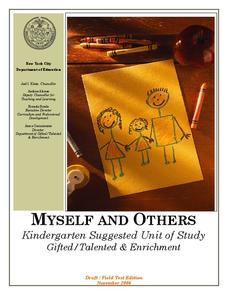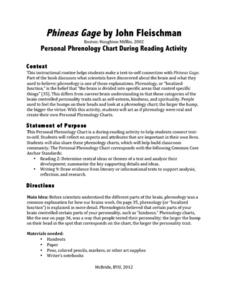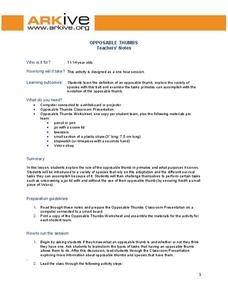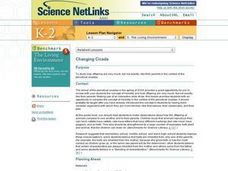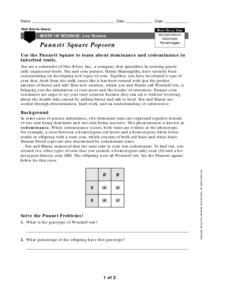Howard Hughes Medical Institute
Understanding Variation
Does where we live influence how our bodies express genetic traits? Explore variation in human skin color with an activity that incorporate video and hands-on learning. Individuals model the relationship between phenotypes and genotypes,...
Columbus City Schools
Asexual and Sexual Reproduction
Can you name a type of reproduction that produces no variation in the offspring? The multimedia lesson covers both sexual and asexual reproduction through videos and discussions. It includes topics such as genetic modification, meiosis,...
New York City Department of Education
Myself and Others
Self reflection is an important skill to reinforce in our children, and it's especially helpful to help them realize who they are in the context of their environment. A collection of lessons about self image and community encourage...
Curated OER
Phineas Gage: Personal Phrenology Chart During Reading Activity
Phrenology, the belief that parts of your brain control certain aspects of your personality, is described in Phineas Gage: A Gruesome but True Story About Brain Science. While we now know much more about the brain, learners use this...
University of Colorado
Punnett Squares with Piebald Deer
Explore the science behind Earth's amazing diversity of life with this lesson on genetics. Looking at specific traits in piebald deer, carnations, and roan cattle, young scientists use Punnett...
US National Library of Medicine
Monster Genetics Lab
Harness young scientists' knowledge of genetics with an engaging science activity. Students start by flipping a coin to determine the genotypes and phenotypes of two parent monsters, before using Punnett squares to...
Oklahoma State University
Hairy Heredity
Young scholars learn that heredity comes down to the flip of a coin with this cross-curricular math and science lesson. Using smiley faces as a model, students toss coins to determine which dominant or recessive traits...
Cherokee County Schools
Dragon Genetics
It's alive! Turn young biologists into mad scientists with this engaging genetics activity. Using their knowledge of chromosomes and genes, students create dragons with unique sets of traits,...
ARKive
Opposable Thumbs
How do opposable thumbs help you complete certain tasks? An activity about evolutionary traits prompts learners to try writing their name, twist the lid off of a jar, and use tweezers to pick up a straw, first with their normal grip, and...
BBSRC
Discovering DNA: The Recipe for Life
A pinch of adenine, a dash of thymine and ta-da, you have life! Well, it's not quite that simple, but through this series of activities and experiments young scientists learn about the structure of DNA and how it contains the recipe...
Curated OER
Changing Cicada
Students discuss inherited traits and relate to the inherited traits in a cicada. In this cicada lesson, students follow the life cycle of the cicada and observe the changes as it grows. Students discuss the characteristics of the...
Curated OER
DNA Detectives
Fifth graders define dominant and recessive genes and that they have DNA from their mother and father. In this inherited traits lesson, 5th graders complete a punnet square based on their parents traits. Students decorate...
Curated OER
Life Science 2c- From Parents to Young -Traits Bulletin Board
Students recognize what traits are inherited. In this inherited traits bulletin board lesson, students complete a chart showing what traits they have inherited and from whom.
Curated OER
Punnett Square Popcorn
In this genetics worksheet, students use the Punnett Square to learn about dominance and codominance in inherited traits. This worksheet has 1 short answer question and 6 problems to solve.
Curated OER
Traits
In this traits worksheet, students will complete a graphic organizer by filling in the definition and an example of inherited, learned, acquired, and manipulated traits.
Curated OER
Heredity
Learners are introduced to the basic principles of heredity. Through discussion and discrimination activities, they review the role of chromosomes and distinguish between those traits that can and cannot be inherited. Students use...
Curated OER
Tracking Down Traits
Sixth graders list traits that all sixth graders share. They receive worksheets "Tracking Down Traits," working in groups to complete the chart. Students share results with the class and a class summary is tallied. Students discuss the...
Curated OER
How Does a Pedigree Help Us to Trace a Trait That is Inherited?
Pupils analyze genetic patterns. In this pedigree lesson, students determine dominant or recessive inheritance. They construct a human pedigree from genetic information.
Curated OER
Heredity Worksheet #4
In this genetics worksheet, students use a pedigree to determine if any of the offspring carry a recessive trait. This worksheet has 5 fill in the blank and 5 short answer questions.
Curated OER
Is Our Health Inherited or Acquired?
Fifth graders list the traits they get from their parents and distinguish between inherited traits from acquired ones. They assess how to recognize influences that may affect body types and sizes and research on the internet heredity and...
Curated OER
Genetics: You Are Unique
Students investigate genetics as the study of inherited traits. They complete a worksheet.
Curated OER
Genetics- You Are Unique
Students identify inherited traits. In this genetics lesson, students participate in a discussion about traits and use a checklist to identify inherited traits. Students complete a hand-out.
Curated OER
Taster/Non-taster Lab Activity
Students determine if they are tasters or non-tasters and then replicate the experiment with family and peer group members. They collect data from the experiment to determine which trait is dominant.
Curated OER
Family Tree Video
Fifth graders create a video with photos with photos of their family members. They demonstrate an explain of traits that are inherited.




